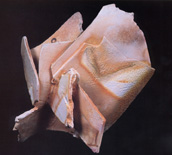Without Laws
by Paul Soldner
|
A leader is best A few years ago, I was doing a workshop at a school with a strong clay program. When my session was finished, one of the students asked me to critique his work. I responded with my usual question, "What difference should it make?" As expected, he said it would help him know if he was doing it right! Again I asked, "What difference should it make?" This time he gave me a quizzical smile and said that since I was the expert, I should know more than he did. This same reliance on what others think about art has led to a commonly held precept that outside opinion is important...and correct! Both students and teachers rely on it. We foster this attitude when looking at exhibitions, for example. Almost without exception, friends ask, "Do you like it?" Or they offer a defensive, "I don't like it." Other critical declarations reflecting their own tastes are stated wtih an absolute authority that suggets their judgment is important. What difference should it make? On the way to my flight, the previously mentioned student wanted to talk more about my refusal to analyze his work. I explained that making art was different than other academic courses in that the object or concept was a solitary, unique manifestation of each artist's inventive vision, and as far as I was concerned that included students. Of course, we are influenced by other art and artists. Historical examples abound in books, magazines, museums, schools, and more recently in films and video. But, unlike the study of other subjects that depend on using laws of physics, laws of grammar, laws of medicine, laws of math, laws of the law and laws of almost everything, the making of fine art today should be without laws. What difference should it make? Making art, as a profession, is a creative act not unlike scientific invention. It is about the discovery of things not known (or seen) before. At its best, it adds to history instead of repeating history. Put simply, creativity is an individual inventive/creative process. Therefore, if artists rely on the judgment of others, they are not being creative. They may be involved with the field of art, may enjoy making it, but it's as different as being the composer of music or a performer of music. Both are important in their own way, but the composer created the original. Such inventive work may not be easy or immediately accepted. |
Keep in mind the problems of Vincent Van Gogh. He wasn't accepted by the art community, galleries or collectors, and sold only one painting in his lifetime. Nevertheless, because his work was so special, his place in history is now assured. His skill, drive and vision caused the work to be collected, protected, documented, and appreciated, making it undeniably important in the world of Art. If art is essentially a one-person investigation, why then is there the need to critique or be critiqued? One reason seems to be a desire to speed up one's career, to become rich and famous as soon as possible. At the graduate school level, such achievement sometimes seems to be the ultimate goal. Along with learning the politics of Art, students are led to believe there are people and ways that really do hasten the process. And so we look to them for guidance. We long to be told what is good and bad. Given this desire, it's easy to become dependent on, even addicted to, their opinion and even easier to offer an opinion. Thus we elevate the role of teachers, art historians, art critics, reviewers, musuem directors, gallery owners, even collectors, as artistic experts. Because of the power inherent in these roles and our desire for success, is it any wonder we think critiquing should make a difference? At its best, it can. But that requres a very mature (or mad) student, independent enough not to need it, as well as opinion givers secure enough in themselves to withhold personal bias and judgmental pronouncements. Through the years, I found one way to avoid falling into the critiquing trap. When students ask for a critique, I ask that they assemble a body of work, not just one peice or two pieces. Also, that a number of faculty, fellow students and even friends outside the field come and look at it in the relaxed atmosphere of a small party. By the time they have put the work together, they often don't need outside advice. They have been able to critique themselves! I'm sure there are other ways to avoid playing Artistic God, but real problems arise if grades are affected by a critique. Giving grades on artisitc effort seems contradictory. On one hand we expect the students to be original, self-motivated and inventive, but then we judge their success or failure by personal feelings. Such pressure can result in emotional stress, misunderstandings and unfairness. As a student at the Los Angeles Art Institute, I was fortunate to have Peter Voulkos as my mentor. In the two years I was there, I cannot remember having an official critique by Pete. Yet we students gained self-confidence to critique our own work without feeling defensive or the need to please him. Nevertheless, we learned to read Pete's body language, which "told us" what he was feeling. For example, if he smoked his cigarette with an impatient draw, the work could be of better quality. If instead he exhaled with a slow, easy release, then he approved. |
I'll never forget one kiln opening. I had great admiration for Pete's surface embellishment and had tried to duplicate his calligraphy on one of my pots. I must have missed by a mile because as I removed the piece, he gently said, "You don't need to decorate unless you have a reason." He then added quietly, "More good pots are ruined by bad decoration than bad pots are made good. But if you really want to try it, do it on your own 'dogs.' You might make them better." And the young man who wanted me to critique his work? As I was boarding the plane, he laughed and said," I had six different people ask to critique that piece in four days. Thanks for not doing it again."
Pedestal Piece, 91-12, 1991, slab built, with white terra sigillata, low-temperature salt, 23 3/4 inches in height; at Louis Newman Galleries in Beverly Hills, California.
Pedestal Piece, 90-26, 1990, low-fire clay with slip, salt vapor fired, 28 1/2 inches high, by Paul Soldner, Aspen, Colorado.
|
|
Ceramics Monthly, May 1992, pp. 30-31. |



